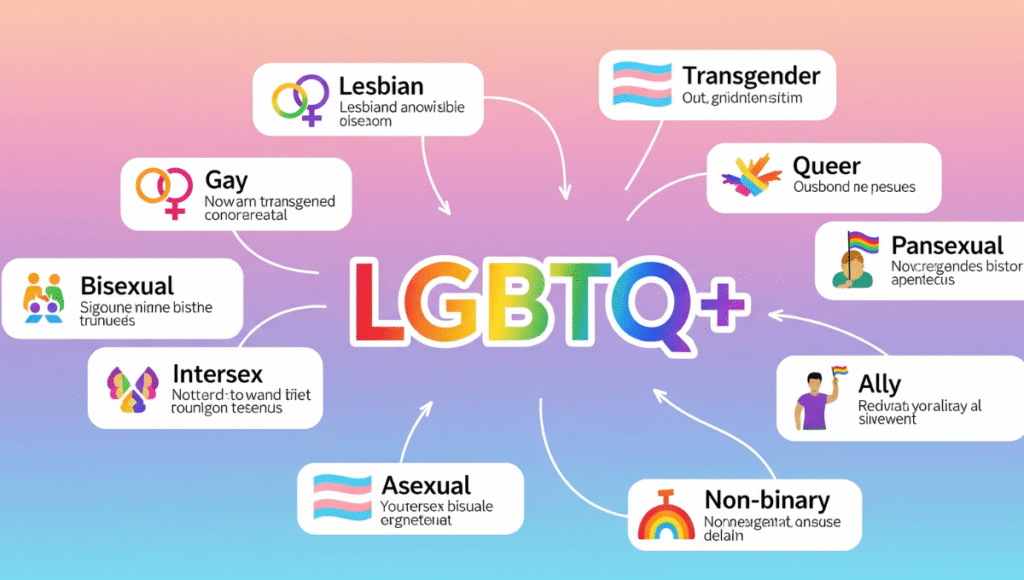Building an understanding of LGBTQ+ language is crucial for encouraging respectful communication and creating a welcoming space for all individuals. Whether you’re just starting to learn about the community or seeking to deepen your understanding, this guide highlights the essential words and concepts that can help you communicate more thoughtfully and accurately.
What Does the LGBTQ+ Acronym Represent?
LGBTQ+ is a broad acronym representing a diverse spectrum of sexual orientations and gender identities:
- L — Lesbian: Women who experience attraction to other women.
- G — Gay: Men who feel attracted to men; also used broadly for homosexual individuals of any gender.
- B — Bisexual: Individuals who experience attraction to multiple genders.
-
T — Transgender: People whose gender identity does not align with the sex they were assigned at birth.
- Q — Queer or Questioning: Queer serves as an umbrella term for non-cisnormative identities; questioning refers to exploring one’s sexual orientation or gender identity.
- +— This symbol includes all other identities outside the main acronym, acknowledging the community’s diversity and the spectrum of gender and sexual identities.
Key LGBTQ+ Terms for Those New to the Community
1. Understanding Sexual Orientation
This describes who someone is emotionally, romantically, or sexually drawn to. Common terms include:

- Heterosexual — The romantic or sexual preference for people of a different gender.
- Homosexual — Attraction to people of the same sex (now frequently replaced by “gay” or “lesbian”).
- Bisexual — Attraction to more than one gender.
- Asexual — Experiencing little or no sexual attraction.
- Pansexual — Attraction that isn’t limited by gender; attracted to people regardless of gender identity.
2. Grasping Gender Identity
Gender identity reflects how someone perceives themselves internally. Important terms are:
- Transgender (Trans) — An individual whose gender identity doesn’t align with the sex assigned at birth.
- Cisgender — An individual whose personal sense of gender aligns with the sex they were assigned at birth.
- Non-binary — Identifies outside the traditional male or female classification.
- Genderqueer — Rejects or challenges conventional gender roles and norms.
- Genderfluid — Experiences changing or fluctuating gender identities over time.
3. Expressing Gender Publicly
Gender expression involves outward behaviors, clothing, speech, and mannerisms through which a person shows their gender identity. Examples include:
- Feminine — Traits or styles traditionally associated with women.
- Masculine — Traits or styles traditionally associated with men.
- Androgynous — A blend or absence of typical male or female characteristics.
4. Romantic vs. Sexual Attraction
While related, romantic and sexual orientations are distinct:
- Heteroromantic — Romantic attraction toward the opposite gender.
- Homoromantic — Romantic attraction toward the same gender.
- Biromantic — Romantic attraction to multiple genders.
5. Other Important Identity Labels
- Intersex — Individuals born with physical sex characteristics that don’t fit typical definitions of male or female.
- Aromantic — An individual who does not feel romantic attraction toward others.
Agender — Someone who identifies as having no specific gender or a neutral gender identity. - Bigender — Feels connected to two different genders.
- Two-Spirit — A culturally specific identity among some Indigenous North American groups, representing a unique gender or spiritual role.
Communicating Respectfully
- Always respect and use the names and pronouns that individuals specify to affirm their identity and foster an inclusive environment.
- Don’t make assumptions based on someone’s appearance or behavior.
- When unsure, politely ask or default to gender-neutral language.
- Honor how people choose to identify themselves.
Common Myths Debunked
- “LGBTQ+ serves as a broad collective term rather than a specific sexual orientation or gender identity.
- Being transgender isn’t a mental illness. It’s a valid gender identity.
- Bisexuality is a legitimate sexual orientation, not confusion or indecisiveness.
Why Familiarity with LGBTQ+ Terms Is Important
- Encourages respectful and inclusive interactions.
- Strengthens relationships through better understanding.
- Promotes respectful communication across personal, educational, and workplace environments.
- Fosters greater awareness and acceptance of diverse identities.
Final Advice for Those Starting Out
- Continue learning, as terminology and understanding evolve over time.
- Practice active listening and respect each person’s self-identification.
- Utilize trusted resources such as GLAAD, PFLAG, and The Trevor Project for the latest information.
- Remember, the goal is to cultivate kindness, empathy, and understanding.
In Conclusion
Mastering LGBTQ+ terminology is a crucial step toward building a more inclusive and accepting society. Whether you’re engaging in conversations, supporting friends, or advocating for equality, knowing these terms will enhance your ability to communicate with respect and sensitivity.
If you’re interested in further exploring LGBTQ+ topics or need visual aids, consider visiting reputable organizations dedicated to LGBTQ+ education and advocacy.
